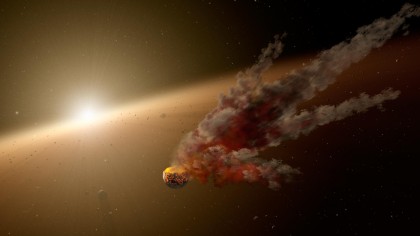How to build a Death Star
Now who's going to pick up the tab?
The final component to worry about is the massive planet-destroying laser carried aboard the Death Star – its very raison d'être. "It's not a laser, because it doesn't travel fast enough", says Allain, who declines to guess at what it actually is. "But the energy required to blow up a planet is just ginormous."
How ginormous? Depends on the planet. In 2011, David Boulderstone, Calum Meredith and Simon Clapton from the University of Leicester wrote a research paper that includes a formula for calculating that energy. A simplified Earth-like planet would need 225,000,000,000,000,000,000,000,000,000,000 joules of energy. Jupiter? Try ten thousand times that amount. No technology we have today can deliver anything close to that level of power.
But let's pretend it could and we built the thing anyway. We'd need to test it, right? I ask my experts which planet in the solar system we should blow up for testing purposes. "I'd go for Uranus, just because it's fun to say," suggests Allain, a little offhandedly.
Nergaard, on the other hand, tries to deflect the question entirely. "Why not try to use the huge laser to try to change it so that it could maybe sustain life?" he asks. "Because then it wouldn't be a Death Star, it'd be a Life Star," I reply. "True," he says, then gets into the spirit of things. "Why not start with Phobos and Deimos – the moons of Mars? Start with them, see how that works out. They're a nice size to blow up."
"It needs to be a planet," I insist. "Then… I don't know," he replied. "Right now, Venus is pretty to look at from the earth. So if you wanted something spectacular you should blow up Venus I think. It has no chance of sustaining any kind of life, and people would be able to see the explosion from here."

So we've got our Death Star. We've got water, food, power and a massive great big weapon that may or may not be a laser. We've got a test subject. Who's picking up the check for all this? Economics blog Centives calculated that a Death Star made of steel would cost about $852,000,000,000,000,000 at 2012 prices. That's in the region of 13,000 times the world's GDP, and it'd take 830 years to mine it.
And what about the cleaning bill? Centives also calculated that mopping the floors of the Death Star once a year would require 48 million people – about a third of the United States' total labour force. Paying all those workers at the current US minimum wage would cost about $723 billion, or a third of the federal government's annual budget.
Sign up for breaking news, reviews, opinion, top tech deals, and more.
It's no wonder, therefore, that in 2013 the US government politely declined a petition signed by 34,000 people to begin construction immediately. "Why would we spend countless taxpayer dollars on a Death Star with a fundamental flaw that can be exploited by a one-man starship?" asked White House science and technology advisor Paul Shawcross.
So there you have it. Everything you need to build and run a Death Star of your very own, minus the actual materials, labour, power, and financing. You'll need to supply those yourself. I asked Nergaard if he had any tips to anyone who wanted to actually build one. "Try to avoid red tape," he said. "That is the biggest challenge that space has. Most things, even a Death Star – well not one as big as that – are actually possible. They're constrained by the fact that people don't want to invest money in it right now for obvious reasons, and by politics! That's it! Otherwise we're almost there."
